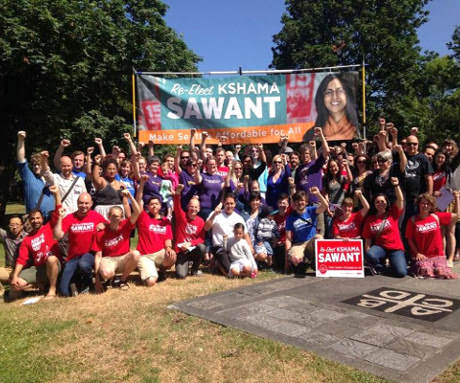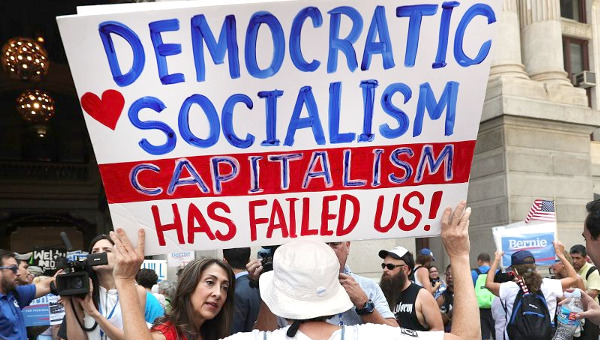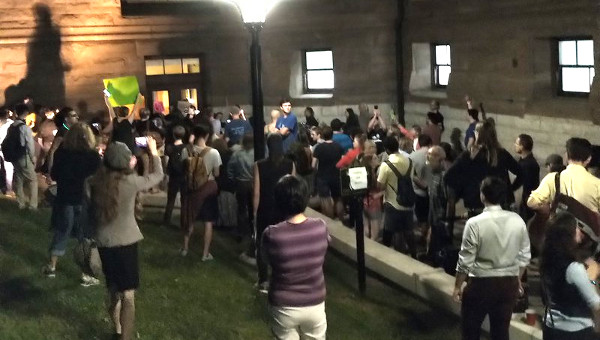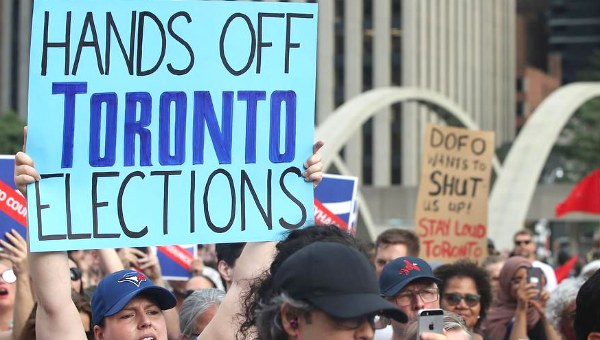The headline in mic.com ran: “Meet the Most Important Socialist in America Not Named Bernie Sanders.” It was about the impact of open Socialist, Kshama Sawant, who had just been reelected in a Seattle Council election. The article went on to say, “Sanders isn’t the only socialist in the United States making a splash. Kshama Sawant, a member of Seattle’s city council since her election in 2013, has a tiny fraction of the name recognition of Sanders. But she’s quietly been making an impact that is arguably just as important, having led the charge for a $15 minimum wage in Seattle, which in turn sparked a national movement and has become a major litmus test for Democratic politicians.”
 Sawant’s 2013 victory sent shock waves through the Seattle establishment by unseating a seemingly entrenched Democratic incumbent to squeeze out a narrow victory. Over the next two years, the big question became framed as: was this a one-off fluke or would she be able to make a difference as a lone socialist, take on the local establishment and still get reelected? The answer came as a resounding yes when the ballots were counted and Sawant came in with 56 per cent to her opponent’s 44 per cent. So what had happened in the previous four years to allow this to happen and what lessons, if any, can be drawn for the Canadian left (whether that left is inside the NDP or outside)?
Sawant’s 2013 victory sent shock waves through the Seattle establishment by unseating a seemingly entrenched Democratic incumbent to squeeze out a narrow victory. Over the next two years, the big question became framed as: was this a one-off fluke or would she be able to make a difference as a lone socialist, take on the local establishment and still get reelected? The answer came as a resounding yes when the ballots were counted and Sawant came in with 56 per cent to her opponent’s 44 per cent. So what had happened in the previous four years to allow this to happen and what lessons, if any, can be drawn for the Canadian left (whether that left is inside the NDP or outside)?
Activism and Electoralism
You have to go back to the heady days of non-electoral politics in the U.S., the Occupy movement. Occupy in Seattle had been one of the stronger ones in the USA. Like most others it saw the participation of the various left groups and, like most others, the movement
dissipated after a few months. Sawant herself was prominent in Occupy Seattle – she was the person who went to her union, AFT Local 1789, to push them to get the City College administration to open up the grounds of Seattle Central College for the Occupy encampment to move to after they were cleared from downtown by the police. They remained there for two months. Sawant joined with other Occupy activists working with local organizations to resist home evictions and foreclosures. She was arrested with several other Occupy activists … for blocking King County Sheriff’s Deputies from evicting a man from his home.
As the direct activism ebbed in Seattle, one of the left groups, Socialist Alternative (SA) proposed that Occupy should test out the electoral arena by running candidates in the 2012 State elections. The suggestion did not find an echo so SA decided to run a candidate under its own banner. Even at that time, the Seattle branch of SA had a strong base with some 50 members. Sawant was the lucky one to run. It was against Frank Chopp, Democratic Speaker of the Washington State House and the second most powerful politician in the State. She didn’t win but got a creditable 29 per cent support. The endorsement of Seattle’s alternative paper, The Stranger, played a significant role in the socialist outlier getting such a noteworthy result. This was an encouragement for future endeavours.
First Victory in 2013
For the city Council elections of 2013, SA decided to run candidates in three cities – Seattle (Kshama Sawant); Minneapolis (Ty Moore) and Boston (Seamus Whelan). Sawant triumphed with 52% beating a 16 year incumbent, dubbed by The Stranger as “a greenwashing liberal fraud.” Moore got 49% – coming within 229 votes of winning the seat. Whelan’s campaign, while it had some local impact, was unable to break out of a crowded field. All three candidates ran as open Socialists and members of Socialist Alternative on an anti-austerity, anti-capitalist, pro-worker position. The latter included fighting for affordable housing, taxing the rich and support for a city wide enactment of $15 an hour minimum wage, a demand that had first taken off the year previously with strikes from fast food workers in New York.
The demand for 15 really gained traction in Seattle and, over the next few months, it came to be identified with Sawant and SA. In the airport area of Seattle, Seatac, a movement for 15 ran concurrently with her campaign and the vote for that initiative, on the same day as Sawant’s Council victory, gained a narrow majority. In Seattle itself, Sawant was originally the only candidate calling for 15, making it her main campaign demand. At the same time the SEIU affiliate, Working Washington, was demonstrating and striking over it, so that by late September 2013, both candidates for Mayor had jumped on the bandwagon – but they didn’t do it until then, while Sawant and SA had been campaigning on it since April.
A Socialist in Office – 15 and Beyond
So she won the 2013 election. What next? She had two choices:
- Be the “good team player” and try to reach consensus with the other members of Council – many councillors were listening to well organized and financed business interests aiming for a watered down 15;
- Build a movement from below – in the streets, the workplaces, union locals and community organizations that would push the Council to implement the strongest possible 15.
Sawant chose option 2, helping to set up the grassroots movement “15Now.” Seattle became the first city in the U.S. to implement 15. It was not without its weaknesses in terms of a long phase in period but it proved to be a trailblazer, with other cities like Los Angeles and San Francisco soon following suit. For more information on this, read the SA article, “How Seattle won 15.”
“According to Sawant, that $15 minimum wage law marked the beginning of a broader social movement. Her message to the troops: Don’t thank the Democratic establishment, the city’s business leaders, the mayor’s office or anyone in Seattle’s ruling class for putting it on the books.
“‘This did not happen because the government suddenly decided to care about workers,’ Sawant said, jabbing a forefinger for emphasis, as she likes to do on the stump. ‘We made it happen. We left them with no choice. They could either support us or be swept aside into the dustbin of history. That is how it’s going to be’.”
Apart from 15, what else? Affordable housing soon became the main issue with three ingredients in the pot – slum landlords, the role of developers, and 100% rent increases from Seattle’s social housing authority. Sawant was the standard bearer inside and outside the Council in calling for rent control. As the Black Lives Matter erupted, Sawant was to the forefront in fighting on issues of police harassment of blacks. She was the only councillor who opposed the building of a new, $2-million youth jail. She took up climate change, protesting Shell’s exploration of the Arctic. She was instrumental in getting the City to rename October 10 celebrations from Columbus Day to Indigenous People’s Day. She had long been involved in LBGTQ issues. Sawant describes her achievements on her own website.
She didn’t engage in these activities without making enemies. The mainstream media portrayed her as abrasive, a demagogue who enjoyed grandstanding on her socialist pulpit, prone to “dwelling too much on national left wing politics rather than dealing with her constituents,” (as reported in the Al Jazeera article). And naturally she didn’t endear herself to her Council colleagues – 6 out of 8 of them, in unprecedented fashion, endorsed her opponent in the 2015 election. An article in The Stranger noted that “Kshama Sawant is pissing off her fellow council members, but that may only strengthen her base.”
Re-election 2015
So this year’s election arrived. First the primary (yes, this is the U.S. and they have primaries even for Council elections). In August, Sawant came in first with 53% and her opponent, Pamela Banks (an African-American Democrat) got 35%. The remaining candidates were eliminated and the ensuing General Election in November would be between Sawant and Banks. The stage was set for an epic battle. On the one hand was the Sawant grassroots campaign and its backbone, Socialist Alternative – by Election Day, they had raised $450,000 (not a cent from corporate money) and mobilized 600 volunteers. Banks, on the other hand, had to rely on donations from corporate CEOs and support from PACs, including one that was set up by Republicans.
I travelled to Seattle to spend the last five days of the campaign working for Sawant. I had had previous experience working on NDP elections in Toronto. One difference in format between elections in the two cities is that Seattle elections are by mail-in ballot – you can send in your ballot three weeks before E-day and your vote is counted so long as it is postmarked no later than E-day. Apart from that, I was struck by a couple of differences between the Sawant campaign and a typical NDP one in Toronto:
- The campaign wasn’t just about conducting a head count to see who were your supporters and then building up to a concerted effort to “get out the vote.” Political issues were front and foremost.
- The campaign was super organized, brimming with enthusiasm from paid and volunteer helpers. There were huge numbers of lawn signs, mailers and literature drops. In addition, you had phone banking and canvassing using state of the art technology. Recording voter information on paper has all but disappeared.
An Inspiring Campaign
An In These Times article elaborated further:
“Sawant’s campaign mobilized over 600 volunteers, knocked on more than 90,000 doors, placed more than 170,000 phone calls and raised more than $450,000, with no money from corporate backers. It also engaged in a sophisticated voter ID operation, slicing up the Capitol Hill district into scores of blocs according to turnout and what percentage voted for Sawant in the August primary. The campaign then identified likely voters, ranked them on their degree of support for Sawant, and engaged them multiple times to turn them into votes. It was a concrete example of how labour, when well organized, can beat capital. Banks’ campaign expenditures were mostly on consultants and advertising, while Sawant’s went toward labour and literature.
“Such intensive retail politics is a rare type of organizing experience for the radical left these days. Dozens of Socialist Alternative members from across the country decamped to Seattle to work on the campaign, with some volunteering for months. The Sawant campaign did not have to re-invent the wheel either. As part of the Committee for a Workers International, Socialist Alternative also drew on the membership and electoral experience of parties in other countries to assist them in organizing and executing a successful electoral strategy.”
One of the SA fulltimers quipped at the victory party that it was the first half a million dollar Marxist campaign in American history.
The Red Machine
As to the campaign organization, I’ve seen nothing like it. I’m not fond of the word ‘professional’ but the SA people running the campaign were super organized – one could describe it as a well oiled, red machine. They had the phone banks, using sophisticated software but most impressive, technology wise, was the new way of door to door canvassing – no more clipboards, paper maps and paper lists of voters. Now it’s all done on smart phones with the relevant voter data downloaded on an app, GPS to guide you street by street, house by house. This app enabled you to input new information as you went and have it immediately uploaded to the central office computers (and to the smart phones of your fellow door knockers). No problem if you didn’t have your own smart phone – they provided you with a “burner” phone; it felt like an episode of “The Wire.”
Other aspects of the campaign that I liked – “stand outs,” i.e. standing/jumping/shouting in groups, at major intersections in morning rush hour to get the attention of passing
drivers/pedestrians. And then my favourite – tabling, i.e. putting up tables on sidewalks outside busy shopping areas, giving out literature, asking people if they’ve voted yet (see above about mail-in elections) and getting them to sign a petition rejecting corporate financing of elections.
Of course, the politics was important. The most popular T-shirt for the volunteers had the slogan “I’m voting for the socialist.” Never have I felt so much at ease in raising socialist ideas with ‘ordinary’ people. Sawant had tremendous name recognition and was widely seen as someone who gets things done, challenges the powers that be and generally kicks up a storm. But it would be false to conclude that Seattle has gone socialist. It is true that over the past two years, under the influence of Sawant, the Council got dragged leftward. However, in these elections, progressive Democrat challengers didn’t do so well in unseating right wing incumbents (a couple came very close). This may mean that Sawant could be short of Council allies in pushing forward her agenda.
Last but not least, the organization that gave backbone to the campaign – Socialist Alternative. The majority of full time campaign workers were SA members, most volunteers were either SA members or supporters. But there were quite a few unaligned progressives working for her and there were local folk who just liked her, were attracted by one or more the issues she was prominently associated with – rent control, 15 Now, LBGQT rights, anti-racism, supporting workers’ struggles etc. And I wasn’t the only one to come from afar to help – a couple of older women (no connection to SA) just turned up from Alaska to spend the last few days on the campaign.
Lessons For the Left in Canada
So could a socialist win a city election in Toronto (or anywhere else in Canada)? Before answering that question, we should all pause for breath and see where we are in terms of agreement or not on the need to build a socialist party independent of the NDP. A year ago Sam Gindin and Michael Hurley published an interesting piece in The Bullet, “Working Class Politics after the NDP,” where they argued for the building of such a force and wrote:
“There are currently a good many individuals doing great political work but they are spread across the activist diaspora as independent and relatively isolated actors. Moreover, their preoccupation with their particular activity doesn’t address the issues confronting the working class as a whole. If we are to seriously face up to those larger challenges, we have to develop a project that connects these individuals and coordinates the pursuit toward a shared national political project. It means developing a socialist political analysis that addresses our times and distributes it among labour and movement activists for further discussion and strategizing. Past experience should make it clear that this cannot happen without developing an organizational capacity to act collectively…
“… Discussions on all this do not have to wait. The capacity certainly exists to hold meetings in Toronto, Ottawa, Halifax, Winnipeg, Edmonton and BC to bring together those interested in moving to a new politics and to assess possibilities. Some coordination of those discussions will be needed, to learn from the variety of experiences that occur, move to some common infrastructure of analysis, information and materials, and also to play a role in encouraging further meetings to advance the discussion in many more communities.”
Can a socialist councillor get elected in Canada? I would say that a combination of objective and subjective factors make an outright election victory in this country highly unlikely in the near future which does not mean to say that we should give up on mounting a campaign and doing our best. Comparing Seattle and Toronto, I would make these points:
- Seattle is essentially a one party city – the Democrats. The Republicans have the status of fringe party. This made it easier for a left of centre challenge. In Toronto, whatever the ward, a socialist would be campaigning against what many would perceive as two ‘left’ candidates – Liberal and NDP, even if these two don’t openly wear their party colours at the municipal level.
- Even following the NDP’s poor showing in the last Federal election, few activists are talking of the need for a new party on the left. Gindin and Hurley wrote 15 months ago that “the capacity certainly exists to hold meetings in Toronto … to bring together those interested in moving to a new politics and to assess possibilities.” I am with them in wanting this to happen but are we any nearer to seeing that first meeting?
- Even at the first time of Sawant running (2012), Seattle had a cohesive, well organized force in the form of the local SA branch. Toronto has nothing like this. The left forces outside the NDP are weak and have no real tradition of working together. Yes, the capacity exists but can it be realized?
- Seattle had a charismatic, dynamic candidate with a record of activism in Occupy. Who would fill that bill in Toronto?
- The key Seattle trade unions were heavily involved in the fight for 15. The unions in Toronto might pay lip service to 15 but their presence on the ground is minimal. (Of course, 15 might not be the issue to act as a lightning rod in Toronto in 2018 – it could well be something else such as housing or transit).
While the issue of standing an independent left candidate(s) in municipal elections is linked to the formation of a national left party outside the NDP, a failure of this party to emerge should not necessarily be a barrier to taking an initiative in Toronto or elsewhere regarding city elections in 2018. After all, SA in the U.S. has long had the position of working to develop a mass Labor Party to the left of the Democrats but the absence of such a party did not prevent them from venturing into electoral politics under their own banner at the local level.
There is no blueprint for a successful left intervention in municipal politics in Canada. As the above points suggest, the Seattle model cannot simply be transposed to here. A victory would be sweet but a showing of anything above 15 per cent, the first time out, should be considered a success. Some factors to consider:
- The candidate – you need a person prepared to articulate a socialist programme, who has a record of activism combined with good community credentials in the ward s/he is contesting;
- Person power – can we mobilize a sizeable number of volunteers (50+)?;
- Money – can we raise $20,000, or more?;
- Endorsements – can we cut into labour’s traditional support for so-called ‘progressive’ candidates, i.e Liberals or NDPers?
Electoral politics is not an obvious comfort zone for many on the left. Meetings, demonstrations, selling papers, flitting from one hot issue to the next seem to be the more natural fit. Yet there is no logical or principled contradiction between issue based activism and electoral interventions. The success of Kshama Sawant in Seattle has demonstrated this. At the national level in the U.S., the interest in socialist ideas that has come to the fore in the wake of the Bernie Sanders campaign also shows the importance of the electoral arena. We would be foolish to ignore an opportunity that beckons. And we have three years to prepare for it. •





